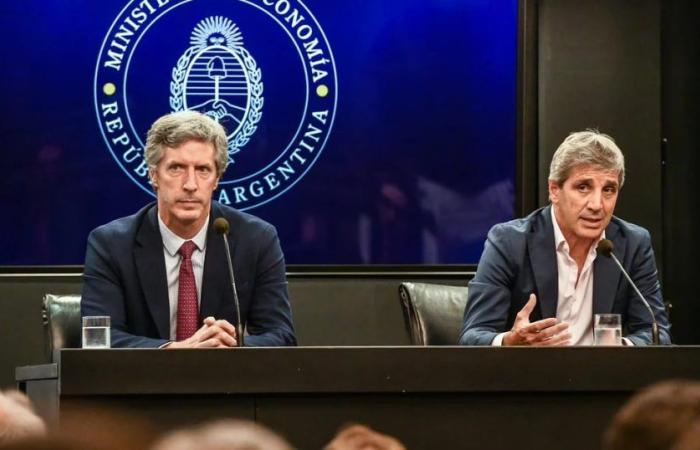
The Government evaluates variants to end one of the fronts that threaten the monetary plan of the economic team and that is presented as an obstacle to the lifting of exchange controls and the coin competition. It is about the putsthe “insurance” held by the banks and that gives them the option of selling their Treasury bonds to the Central Bank and which add up to $19 billion.
In this context, this week the Ministry of Economy will seek, through another debt tender in pesos, to continue with the brand new scheme of positive interest rates, an element required by the Monetary Fund as part of a next stage of economic policy management. In the short horizon, for the Government, maturities for 2.4 billion pesos of a dual bonus.
Officials from the Ministry of Economy and the Central Bank have been evaluating for weeks an exit for the insurance system. puts that inaugurated the management of Sergio Massa to ensure that banks buy the securities in local currency issued by the Ministry of Finance. Under this right, holders can activate a sale right before the BCRA, which must thus buy their holding at the price before the last closing. For that, the monetary authority would need to issue pesos.
The bonds with this clause were growing: they continued under the new economic management and adopted, in recent months, a characteristic that made them less demanding for the balance sheet of the monetary authority. While the original version of the puts gave the chance to be exercised whenever of the duration of the bonus, the most updated one only allows it during the last month term of the title in question.
Economy and the Central Bank have been evaluating for weeks an exit for the put system that was inaugurated by Sergio Massa’s administration to ensure that banks buy the securities in local currency issued by the Ministry of Finance
In any case, it still flies over that potential mass of pesos for issuance, which was pointed out on different occasions by the president. Javier Milei as one of the obstacles to ending exchange controls. “Once we solve that, bye,” she mentioned a few weeks ago. She reiterated a similar idea this weekend during her “awards” tour in Europe. “I need to close the agreement for the puts and in that I have to agree with the banks“he said in Madrid.
Among the banks consulted by Infobaewhich are the main holders of Treasury securities with putsthey hope that in the coming weeks a way out of this mess will be defined for the economic team and they await a “market” solution -that is, not forced- such as an exchange for other titles or without the clause of put or with the milder version in exchange for a longer duration or rate. The agency Bloomberg published that the BCRA began formal conversations with a group of banks with holdings of those puts.
Some reports in the market put numbers on the question of sale options and ventured exit possibilities, with the eventual costs they would have for the economy. “In our opinion, the puts They are not an obvious impediment to lifting exchange controlsin the sense that depositors (who are the true demanders of pesos) might want to dollarize their portfolios regardless of whether the banks have their bonds covered or not covered with puts“, they said since 1816.
“I need to close the agreement for the puts and on that I have to agree with the banks,” said president Javier Milei in Madrid.
“On the other hand, it is clearer that the puts They are a limitation to go to the ‘currency competition’ scheme proposed by Milei in which the stock of pesos remains fixed, because that would require eliminating all sources of currency printing,” including that which could result from the activation of the puts.
According to estimates from that consulting firm, the banks exercised puts to the tune of around $5.5 billion so far this year. The number rises to $8.8 billion when calculating in constant pesos. “In other words, banks have effectively used puts to manage their portfolios in recent times,” they mentioned. In overall numbers, there would be $19 billion of bonds with putsalthough $16.5 billion They are what the economic team would aim to “solve.”
On that level, 1816 proposed that a possible solution would be a repurchase of these bonds by the Economy. “One option would be to exchange the long bonds with the banks with puts by short titles without puts, like Lecaps, which have greater liquidity in the market. In exchange for eliminating the putswith such an operation the Government would shorten the deadline average of their debt,” they mentioned.
“The stock of 2026 and 2027 titles with puts (being with puts We know that they are in the hands of banks) is around $8.1 trillion at current market value, which is an amount equivalent to 49% of the monetary base or 35% of private fixed terms in pesos. If we take the total stock of puts American loans (those that can be exercised at any time), including those that expire in 2024 and 2025, represent 99% of the base and 72% of the fixed terms,” said 1816.
The Monetary Fund acknowledged to the Government, on the one hand, that the issue of sales insurance They were “inherited” of the previous government and, on the other, the management of the debt in pesos of recent months. “Active management of public debt has reduced refinancing risks, including through a voluntary swap that successfully extended 40% of all outstanding peso debt this year (6.5% of GDP) to inflation-indexed securities maturing in 2025-28, generating a substantially improved,” mentioned the IMF technicians. The duration passed, on average, from 6 months to 3 years with lower interest.
Among the banks, they expect a “market” solution – that is, not forced – such as an exchange for other securities either without the put clause or with the lighter version in exchange for a longer duration or rate.
“To reduce debt vulnerabilities and build the Treasury yield curve, efforts continue to shift toward fixed rate instruments (far from values indexed to inflation and the exchange rate), eliminate the central bank’s costly insurance (sales) and move from the BCRA to Treasury securities,” he anticipated.
It is on this level that the Ministry of Finance will try to move again, which plans to carry out this week the second and last debt tender in pesos of this month. According to information from the Congressional Budget Office (OCP), some 2.4 billion pesos of a dual bonus.
Lecap’s last operation represented, according to the economic team, the end of the era of the negative interest rate against inflation. It is inferred, therefore, that the rate of Capitalizable Bills would become positive, something that appeared to be very relevant in the exchange between Buenos Aires and Washington: favorable rates in the face of inflation are usually one of the workhorses of the IMF.





